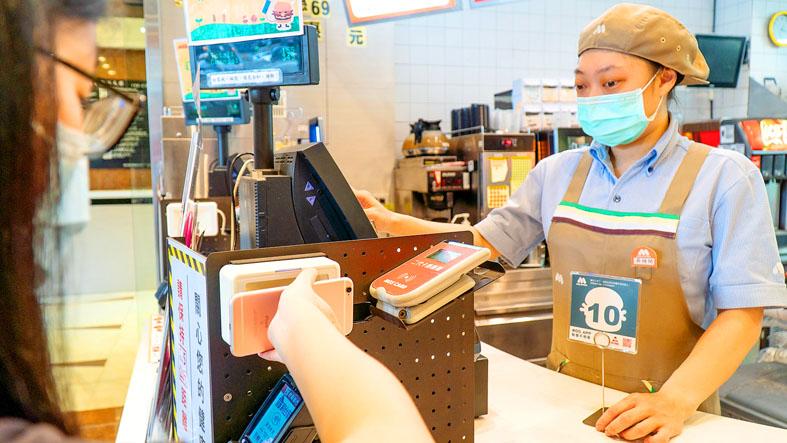Mobile payments in Taiwan last year more than doubled to NT$240.7 billion (US$8.54 billion) from NT$118.2 billion a year earlier as a trend toward ditching wallets and paying with mobile devices continued, Financial Supervisory Commission (FSC) data showed yesterday.
Growth of mobile payments has at least doubled each year since 2016, when it totaled NT$1.49 billion, rising to NT$14.8 billion in 2017 and NT$47.8 billion in 2018, the data showed.
The commission defines mobile payments as those conducted on a personal mobile device via electronic payment platforms such as Line Pay and Jkos Pay, as well as credit card, debit card or stored value card spending through mobile wallets, such as Apple Pay.

Photo courtesy of MOS Burger
Payments made last year through e-payment platforms surged 135 percent from NT$36.2 billion a year earlier to NT$85.4 billion.
The method ranked top among all mobile payment tools, which could be attributed to e-payment services offering more incentives than other providers, the commission said.
It was the first time that e-payment services outperformed platform-based credit card or debit card spending, the data showed.
“We have noticed that most mobile payments are for retail spending in the real world, instead of online shopping,” Banking Bureau Deputy Director-General Lin Chih-chi (林志吉) said by telephone.
People still prefer credit cards to shop online, but when they buy snacks, beverages or consumer goods at physical stores, they prefer using e-payment services to avoid using a wallet and earn reward points, Lin said.
Teenagers, who are not allowed credit cards, but can use mobile e-payment services by linking a bank account to an e-payment platform, helped boost mobile payments, the FSC said.
Platform-based debit card spending was the second-most popular method last year, accounting for NT$72.5 billion and up 158 percent year-on-year, while platform-based credit card spending was third, up 54 percent annually to NT$68.9 billion, the data showed.
Payments via mobile point-of-sale devices totaled NT$5.1 billion, up 13 percent from a year earlier, while payments via electronic stored value cards rose 63 percent to NT$1.8 billion, the data showed.
Mobile payments remain a comparatively small percentage of non-cash payments, which totaled NT$4.95 trillion last year, but the proportion is expected to keep growing, the commission said.
Cumulative mobile payments since 2016 totaled NT$423 billion as of the end of last year, up 132 percent from a year earlier, the data showed.

The US dollar was trading at NT$29.7 at 10am today on the Taipei Foreign Exchange, as the New Taiwan dollar gained NT$1.364 from the previous close last week. The NT dollar continued to rise today, after surging 3.07 percent on Friday. After opening at NT$30.91, the NT dollar gained more than NT$1 in just 15 minutes, briefly passing the NT$30 mark. Before the US Department of the Treasury's semi-annual currency report came out, expectations that the NT dollar would keep rising were already building. The NT dollar on Friday closed at NT$31.064, up by NT$0.953 — a 3.07 percent single-day gain. Today,

‘SHORT TERM’: The local currency would likely remain strong in the near term, driven by anticipated US trade pressure, capital inflows and expectations of a US Fed rate cut The US dollar is expected to fall below NT$30 in the near term, as traders anticipate increased pressure from Washington for Taiwan to allow the New Taiwan dollar to appreciate, Cathay United Bank (國泰世華銀行) chief economist Lin Chi-chao (林啟超) said. Following a sharp drop in the greenback against the NT dollar on Friday, Lin told the Central News Agency that the local currency is likely to remain strong in the short term, driven in part by market psychology surrounding anticipated US policy pressure. On Friday, the US dollar fell NT$0.953, or 3.07 percent, closing at NT$31.064 — its lowest level since Jan.

Hong Kong authorities ramped up sales of the local dollar as the greenback’s slide threatened the foreign-exchange peg. The Hong Kong Monetary Authority (HKMA) sold a record HK$60.5 billion (US$7.8 billion) of the city’s currency, according to an alert sent on its Bloomberg page yesterday in Asia, after it tested the upper end of its trading band. That added to the HK$56.1 billion of sales versus the greenback since Friday. The rapid intervention signals efforts from the city’s authorities to limit the local currency’s moves within its HK$7.75 to HK$7.85 per US dollar trading band. Heavy sales of the local dollar by

The Financial Supervisory Commission (FSC) yesterday met with some of the nation’s largest insurance companies as a skyrocketing New Taiwan dollar piles pressure on their hundreds of billions of dollars in US bond investments. The commission has asked some life insurance firms, among the biggest Asian holders of US debt, to discuss how the rapidly strengthening NT dollar has impacted their operations, people familiar with the matter said. The meeting took place as the NT dollar jumped as much as 5 percent yesterday, its biggest intraday gain in more than three decades. The local currency surged as exporters rushed to